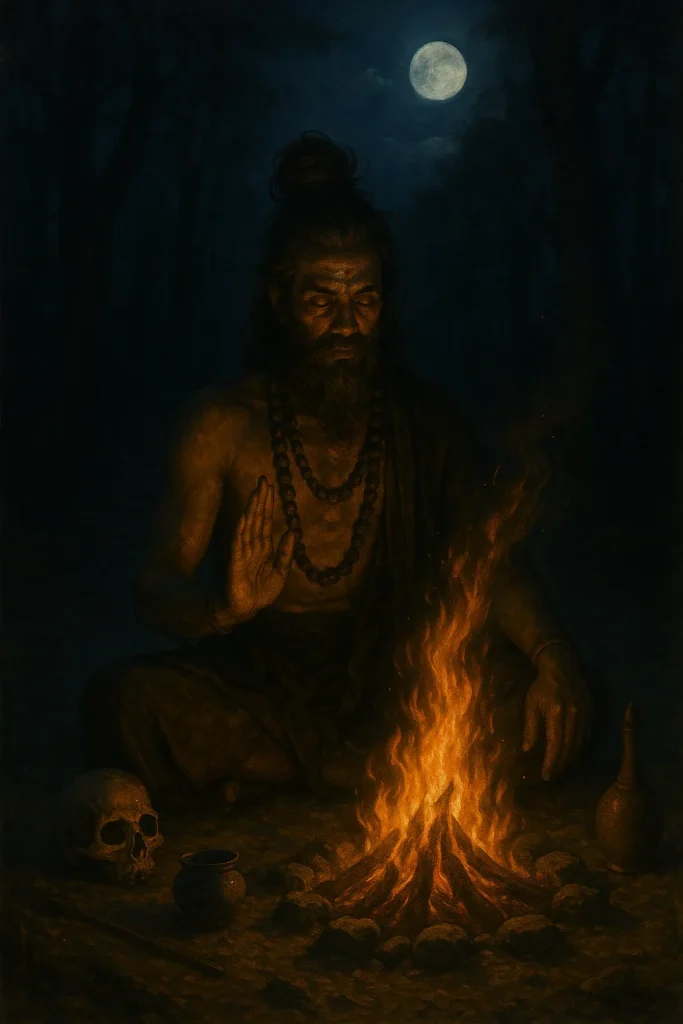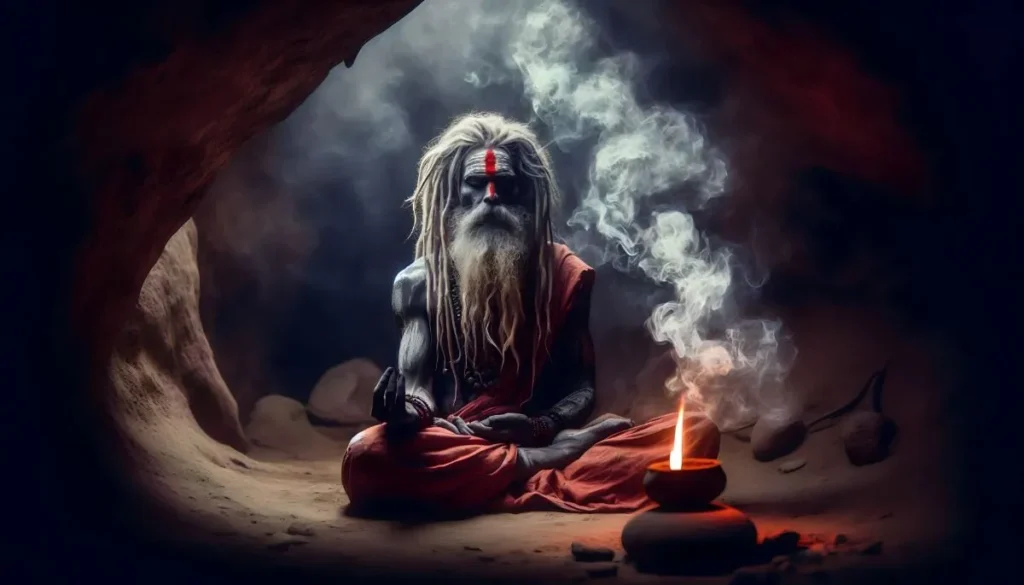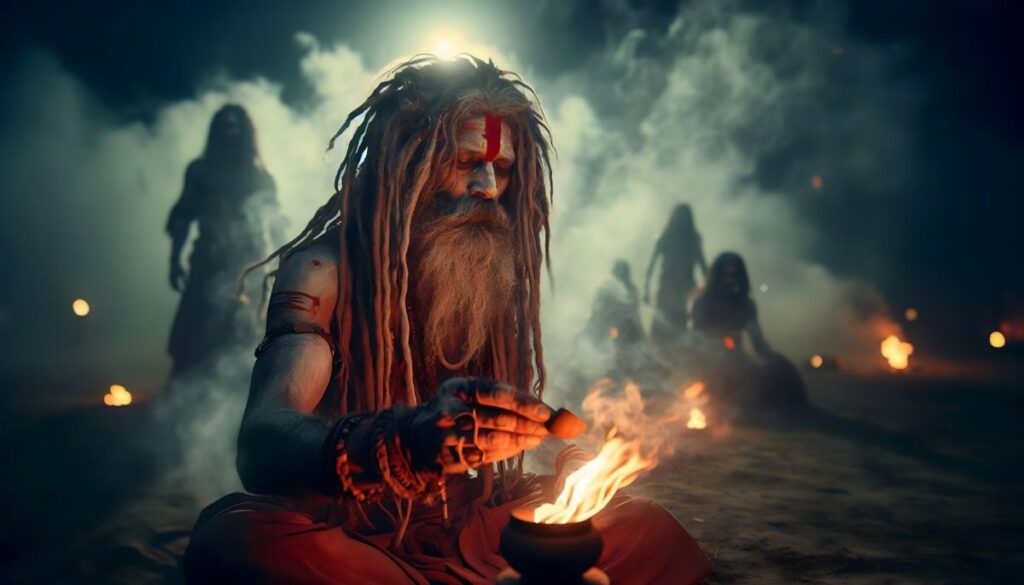The Path of the Tantrik
In the dense jungles, atop desolate cremation grounds, deep within Himalayan caves, and even behind the quiet smile of a householder, exists a figure of mystery and immense spiritual power—the Tantrik.
Not merely a ritualist or a sage, the Tantrik is a spiritual alchemist, walking the razor’s edge between matter and spirit, light and shadow, desire and transcendence. He is feared, respected, misunderstood, and often dismissed. But to those who look deeper, he is a master of transformation, a guardian of sacred secrets, and a bridge between the visible and the invisible realms.
Who is a Tantrik?



A Tantrik is one who practices Tantra, not as superstition or magic, but as a complete path of spiritual evolution. Unlike conventional yogis who may reject the world, the Tantrik embraces the world as divine. For him, every form, emotion, desire, and even taboo is a doorway to the infinite.
He does not suppress. He transcends.
In ancient Sanskrit texts, the Tantrik is called a Vīra—a spiritual warrior, one who has conquered fear, attachment, and duality. His strength is not in muscles but in his ability to hold paradoxes. He sees Shiva in stillness and Shakti in the storm—and bows to both.
The Attributes of a True Tantrik
A real Tantrik is not one who wears ashes or chants spells for money. The outer signs are irrelevant. His power lies within. Here are the core traits of an authentic Tantrik:
- Fearless Awareness:
He walks into haunted places and sits in graveyards—not to boast, but because he has no fear of death or spirits. He knows the only real ghost is ignorance. - Mastery of Mantra and Mind:
He chants not mechanically but with deep Shakti. Each word vibrates through his body. His mantras can heal, awaken, or destroy illusions. - Balanced Desires:
He may partake in wine or fast, indulge or abstain. But nothing owns him. He is desireless in desire—a rare state of detachment in participation. - Sacred Rituals:
The Tantrik performs rituals not for show, but as divine acts. His rituals awaken energies in subtle planes. Fire, water, blood, and breath are his allies. - Inner Silence Amidst Chaos:
He may be in the heart of a noisy world, yet untouched. His inner space is still. He watches everything, clings to nothing.
The Journey of a Tantrik: From Shadow to Light
Becoming a Tantrik is not easy. It is not a technique—it is a transformation. The journey often begins with suffering, solitude, or a divine calling. Here is the inner path he walks:
- Initiation (Dīkṣā):
A true Tantrik is initiated by a Guru who unlocks his subtle body. The Guru may transfer energy (Shaktipāt), a mantra, or a sacred object. Without a lineage (paramparā), the energy can be dangerous. - Shadow Work:
The Tantrik must confront his deepest fears, repressed desires, karmic burdens, and ancestral patterns. He faces ghosts—not just outer ones, but inner ones. - Sādhana (Spiritual Practice):
He may do rituals at midnight, chant bija mantras, meditate on terrifying forms like Kālī, Bhairava, or Chamunda, and awaken Kundalini through breath and will. - Union (Yoga):
The final stage is union—not with a person, but with the cosmic consciousness. The Tantrik becomes one with Shiva and Shakti. He lives like a flame in the wind—untouched, glowing, and free.
Tantrik and the Sādhikā: The Sacred Partnership
When aligned with a Sādhikā, the Tantrik becomes a complete current. She is Shakti, and he is Shiva. Their union is not lust but liberation.
In esoteric Tantra, the Maithuna ritual (ritual union) symbolizes the merging of Purusha (pure awareness) with Prakriti (creative energy). The Tantrik offers stillness; the Sādhikā brings movement. Together, they create spiritual fire that can burn karma across lifetimes.
Misconceptions About Tantriks
Unfortunately, the word “Tantrik” has been stained by fear, media, and imposters. Let us clear the air:
| Myth | Truth |
| Tantriks do black magic | Real Tantriks seek liberation, not control. Some use rituals for protection or healing. |
| They perform immoral rituals | True rituals are symbolic and sacred. Literal use is rare and bound by ethics. |
| They wear skulls and bones | Some do. Most don’t. External appearance is irrelevant to inner power. |
| They are against Hinduism | Tantra is deeply embedded in the Shaiva, Shakta, and even Buddhist traditions. |
| Only men can be Tantriks | False. Many great Sādhikās have led powerful Tantric paths. |
Modern Tantriks: Silent Guides of the Inner World
In the 21st century, the Tantrik may not live in cremation grounds. He may be:
- A teacher blending science and spirit.
- A therapist using mantras and breathwork.
- A householder who does sādhana in his attic.
- A silent renunciate in the Himalayas, unknown to all.
But his eyes burn with knowing. His aura feels different. You will feel him before you hear him. He speaks little—but when he does, it changes the very air.
The Tantrik is Fire, Not Smoke
A true Tantrik is not a mystic for display. He is a mystic who disappears.
He does not seek applause, followers, or fame. He seeks freedom—and then helps others find it.
In a world addicted to light, he walks the path of shadow not to dwell there, but to dissolve it.
He is the hidden current behind the rivers of devotion, the keeper of forgotten mantras, and the storm within silence.
“The Tantrik does not escape the world—he swallows it, digests it, and becomes its master. He is not a slave to rules, nor a rebel without cause. He is the flame between opposites. He is the echo of Shiva’s laughter and Kali’s rage. He is freedom walking.” — Acharya Sailyajit
FAQs
Q1: Who is a Tantrik?
A Tantrik is a spiritual practitioner who follows the Tantric path—using rituals, mantras, and inner transformation to achieve liberation.
Q2: Do Tantriks perform black magic?
True Tantriks do not engage in black magic. Their practices are rooted in sacred knowledge meant for healing, protection, and spiritual evolution.
Q3: Is Tantra only for men?
No. Many powerful female practitioners, called Sādhikās, have walked the Tantric path and played vital roles in the tradition.
Q4: Why do some Tantriks practice in cremation grounds?
Cremation grounds symbolize impermanence and fear. Tantriks meditate there to overcome ego, fear of death, and worldly attachments.
Q5: Can a modern-day person be a Tantrik?
Yes. A Tantrik today might live a normal life—as a teacher, therapist, or householder—while practicing intense inner sādhana silently.
Q6: Are Tantrik rituals immoral or taboo?
Authentic Tantrik rituals are symbolic, sacred, and performed under strict ethical guidance. Misuse or literal interpretations are misconceptions.
Q7: What is the difference between a Tantrik and a yogi?
While a yogi may renounce the world, a Tantrik embraces it as divine. The Tantrik transforms desire rather than rejecting it.
Q8: What role does a Guru play in Tantra?
A Guru initiates and guides the Tantrik, transmitting sacred energy and protecting the seeker during advanced spiritual practices.











